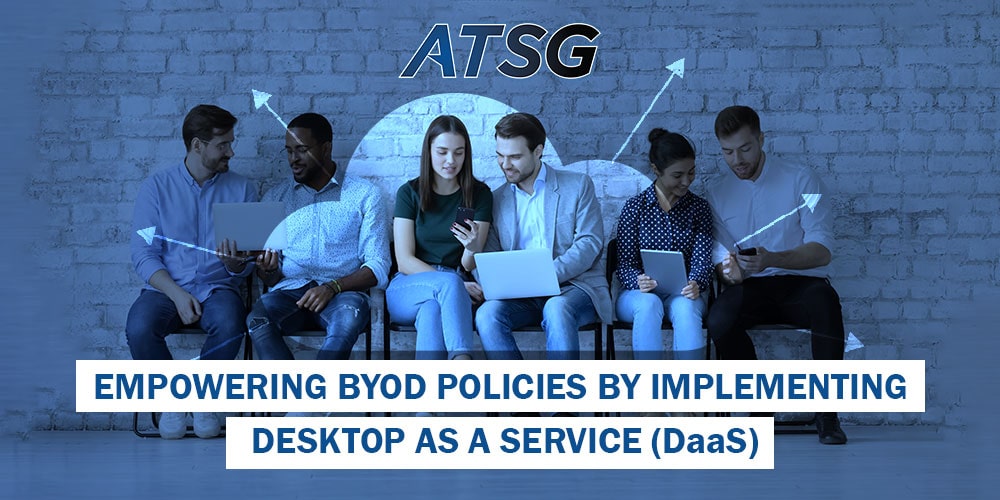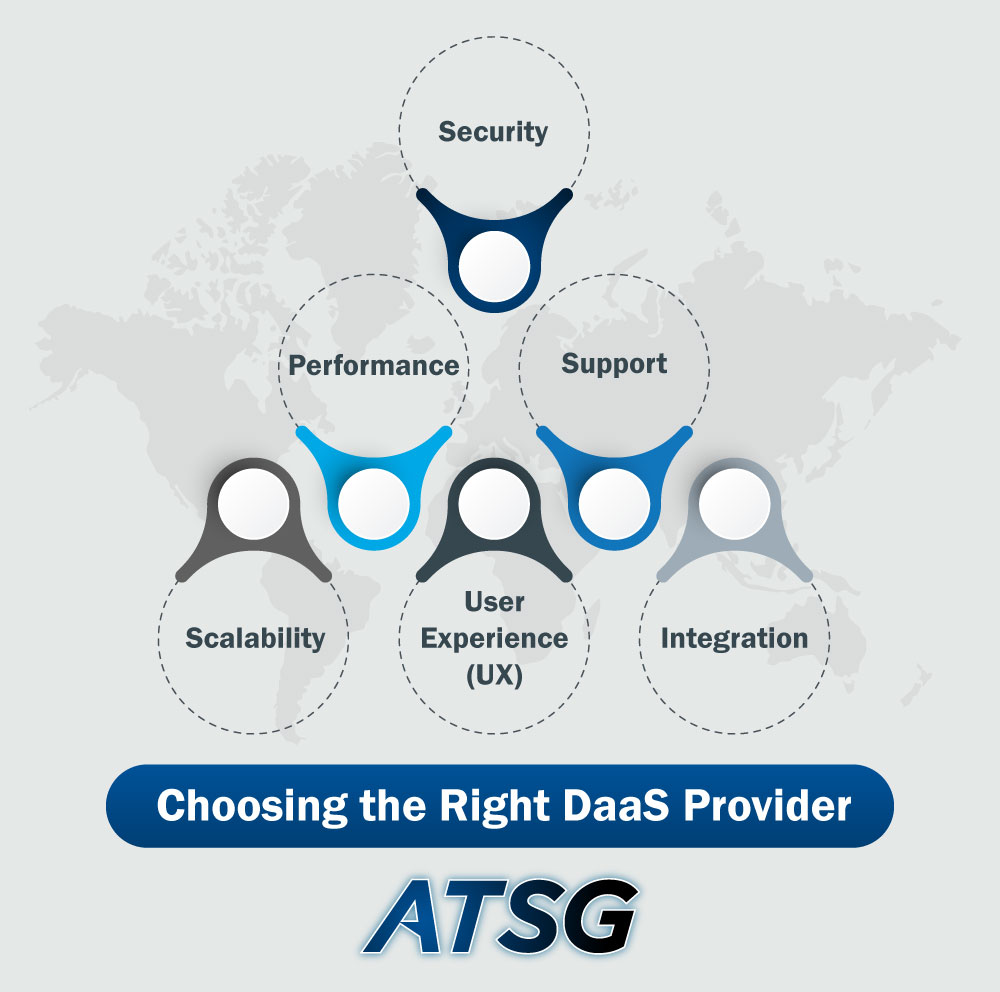As remote office concepts grow in prevalence, it has become increasingly important to adopt newer work models that are both efficient and secure. Organizations look towards finding cost-efficient and highly productive solutions that can operate virtually, and bring the same effect of an on-premise environment. These virtual office infrastructures offered by cloud service providers (CSPs) can help organizations by implementing intelligent IT solutions, such as Bring Your Own Device (BYOD) and Desktop as a Service (DaaS).

These IT solutions ensure business continuity (BC) and growth, allowing employees to maintain focus on the business and their challenges, finding a way to transform and move rapidly towards improvement. However, organizations implementing BYOD have faced several challenges in maintaining robust policies and sustained progress. This is where DaaS solutions and BYOD policies are proving synergetic, and resulting in better outcomes.
Challenges of BYOD Environments and Policies
Integrating bring-your-own-devices has several benefits of ensuring productivity and employee satisfaction. However, there are also several challenges associated with BYOD environments and policies.
-
- Security: One of the main challenges of BYOD is ensuring the security of corporate data on personal devices. With employees accessing company data from their own devices, it can be difficult to fully enforce security policies, and prevent un-authorized access to sensitive information.
- Compliance: Complying with regulations such as General Data Protection Regulation (GDPR), The Health Insurance Portability and Accountability Act (HIPAA), and Sarbanes–Oxley Act (SOX) is essential for businesses in many regulated industries. BYOD policies can make it challenging to meet these compliance requirements, as personal devices may not meet the same security standards as company-owned devices.
- Compatibility: With so many different devices and operating systems in use, it can be difficult to ensure that company applications and data are fully compatible with all devices. This can lead to issues with functionality and data loss.
- Cost: BYOD policies can be cost-effective for businesses, as they do not have to provide devices for all employees. However, businesses may need to invest in mobile device management (MDM) solutions to manage personal devices, which can also be costly.
- Privacy: BYOD policies can raise privacy concerns for employees who may be uncomfortable with the idea of their employer accessing personal data on their devices. It is important to establish clear policies around data access and privacy, to address these concerns.
Exploring Desktop as a Service (DaaS)
DaaS is a high-performance, secure and cost-effective type of desktop virtualization. It frees businesses from tethering their computer operations and productivity software to any physical hardware.
Organizations can use DaaS to access cloud hosted virtual desktops over the internet, being offered by a cloud provider. DaaS allows organizations to provide employees with virtualized environments on any device, with the data and systems hosted in the Cloud. For the modern business world, desktop-as-a-service (DaaS) is a very practical solution, and its adoption is continuously on the rise.
Choosing the Right DaaS Provider
One of the most important steps for implementing DaaS solutions is to find an apt service provider that can help facilitate the organization with all the necessary tools and resources.

The following factors are essential to consider when choosing a DaaS provider.
1. Security
An important factor to consider is security and privacy, with leading DaaS providers having an impeccable track record of maintaining security mechanisms and compliance policies. With DaaS providers, organizations can benefit from multi-layered security and intelligent monitoring tools.
2. Performance
DaaS relies on a fast and reliable internet connection. Organizations need to make sure the provider has a good reputation for delivering high-performance services and minimal downtime.
3. Support
It is important for organizations to consider effective and efficient customer support from the DaaS provider. A good DaaS provider needs to be able to provide the enterprise with reliable support, 24/7 availability, and responsive services.
4. Scalability
As the business grows, it is important that organizations are able to scale their business accordingly. With a DaaS provider, an enterprise needs to be able to accommodate those changes seamlessly, without any disruption to the ongoing business operations.
5. User Experience (UX)
The DaaS provider should offer a user-friendly interface that is easy to navigate and use. Employees often get agitated by change and new tools, which is why it is imperative to make an easy transition and gradually push the employees toward the changes made. DaaS providers need to present demos or training to improve the performance of resources and deliver consistently good user experiences.
6. Integration
Enterprises need to make sure that the DaaS provider they choose offers integrations with other software and services that businesses use. These can range from email, productivity suites, and customer relationship management (CRM) systems, to improve the overall performance of the business.
Step-by-Step Integration of DaaS
The following list explores the steps needed to be taken when integrating Desktop-as-a-Service (DaaS).
1. Define Goals and Objectives: Determine what you hope to achieve with DaaS, for instance, productivity, cost-savings, or flexibility.
2. Assess Current IT Infrastructure: Evaluating the current IT infrastructure means determining whether it can fully support DaaS. The organization must determine if it has the required bandwidth, security measures, and hardware to support a DaaS environment.
3. Identify Specific DaaS Requirements: Identify the specific requirements, such as the number of users and applications that need to run on the system, and the level of support that is required. This will help the organization choose the right DaaS provider, and plan for necessary resources.
4. Choose the Most Suitable DaaS Provider: Researching and comparing different DaaS providers can help organizations find the ideal provider that fits their needs and requirements. Enterprises must consider factors such as security, performance, pricing, scalability, integration, etc.
5. DaaS Implementation Plan: Enterprises must look at factors when integrating DaaS, which include a timeline, contingency plans, and the required resources. This includes researching the environment that can ensure the seamless transition of all applications, resources, and operations to the Cloud.
6. Testing the DaaS Environment: Test the DaaS environment thoroughly to ensure it meets the requirements of the organization, and functions properly. This includes testing application performance, security measures, and data access protocols.
7. Training of Employees: Provide training and support to the employees to ensure they can effectively use the new DaaS environment, and improve the outcomes of the business. This includes training on how to access information, utilize resources, and improve operations without any hindrance.
DaaS and BYOD Policy
DaaS alleviates many of the concerns associated with BYOD. Regardless of what devices employees use and where they log in from, all device-to-server connections are made within the cloud provider’s secure environment. A good DaaS provider can implement various features that deliver and integrate secure BYOD policies aptly and improve business progression.
BYOD is a smart technology to implement, but due to its challenges, DaaS acts as a protective agent for the organization to function and benefit from both solutions in an effective, secure and compliant manner.
Choosing the Best DaaS Provider
Today’s fast-moving world means that companies are either forced to implement digital workplace solutions, or lose to the market competition. However, organizations are struggling to find resources and tools to help elevate BYOD policies in digital workplaces. Solution providers like ATSG save organizations the time and money by deploying tools and software that can help.
ATSG’s Desktop as a Service (DaaS) solution has proved a prime element in customizing solutions according to an organization’s unique needs. ATSG, with its professional and certified teams, assesses work environments, fulfills technology gaps and recreates the roadmap for successful BYOD policies, according to organizational requirements. The result is a cloud desktop solution that provides effective and secure cloud desktops and applications for the workforce, eliminating multiple challenges posed by BYOD policies.




